





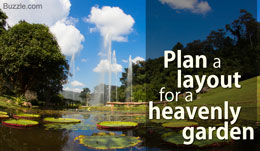 Flowers are essential components of a garden. They are considered as the centerpiece of any garden. In fact, a yard with a lawn, trees, and fountain, looks incomplete until one incorporates flowering plants to its borders and beds. While flowers look great in any kind of landscape design, proper planning enhances the aesthetic value of the yard. So, instead of growing them randomly like flowers in the wild, why not plan the garden layout first and design it neatly?How to Plan a Flower GardenLaying a flower garden requires some forethought, your creativity, and basic gardening skills. But, you don't need a degree in landscape designing to proceed with the same. While planning a flower garden layout, certain criteria should be considered like location, yard space, adding flower beds, finalizing flowering plants, and design tips. And to make your project simpler, make a rough sketch of the layout including the plant placement and color pattern.Decide on the Location
Flowers are essential components of a garden. They are considered as the centerpiece of any garden. In fact, a yard with a lawn, trees, and fountain, looks incomplete until one incorporates flowering plants to its borders and beds. While flowers look great in any kind of landscape design, proper planning enhances the aesthetic value of the yard. So, instead of growing them randomly like flowers in the wild, why not plan the garden layout first and design it neatly?How to Plan a Flower GardenLaying a flower garden requires some forethought, your creativity, and basic gardening skills. But, you don't need a degree in landscape designing to proceed with the same. While planning a flower garden layout, certain criteria should be considered like location, yard space, adding flower beds, finalizing flowering plants, and design tips. And to make your project simpler, make a rough sketch of the layout including the plant placement and color pattern.Decide on the Location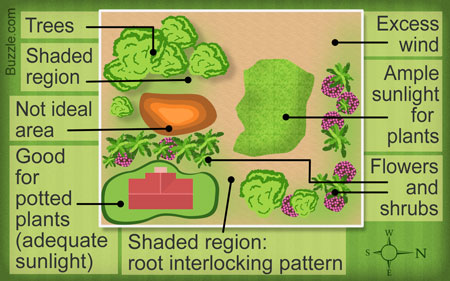 The actual garden layout and the flower varieties to be planted depend on where the area is located. A sunny yard with fertile and well-drained soil is excellent for maintaining a garden. While any piece of land can be made into a beautiful flower garden with some effort, it is better to grow flowers in a suitable area. If possible, try to avoid a shady and damp location. For a shaded garden, the flower options are limited. In fact, colorful blooms look more vibrant in a sunlit garden.
The actual garden layout and the flower varieties to be planted depend on where the area is located. A sunny yard with fertile and well-drained soil is excellent for maintaining a garden. While any piece of land can be made into a beautiful flower garden with some effort, it is better to grow flowers in a suitable area. If possible, try to avoid a shady and damp location. For a shaded garden, the flower options are limited. In fact, colorful blooms look more vibrant in a sunlit garden.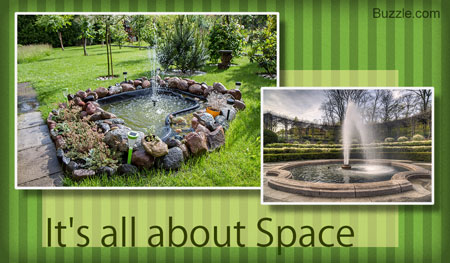 Layout of a flower garden largely depends on how big is the area. So, yard space and total area of the flower beds should be considered first. Later, you can decide the plant types and their position in the garden, based on their height, flowering time, and color.You can also add trellis, stone paths, and alike garden components. What about including a garden pond with colorful fish and water lilies? Depending upon your personal preferences, finalize the color scheme and flower cultivars.Designs for Flower Beds
Layout of a flower garden largely depends on how big is the area. So, yard space and total area of the flower beds should be considered first. Later, you can decide the plant types and their position in the garden, based on their height, flowering time, and color.You can also add trellis, stone paths, and alike garden components. What about including a garden pond with colorful fish and water lilies? Depending upon your personal preferences, finalize the color scheme and flower cultivars.Designs for Flower Beds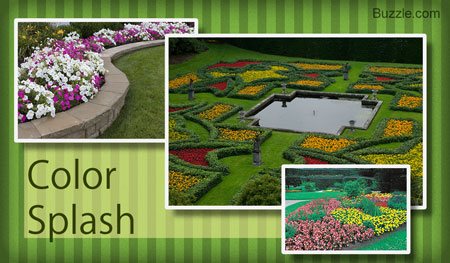 The flower beds should be wide enough (about 5-7 feet) so that you can have better planting options. Each bed can be demarcated from the other by straight or curved lines (as per your choice).A formal garden looks elegant with straight lines. But, if you want something out of the box, select five types of varied colored flowers that bloom at the same time. Plant them in a five-petaled flower shape, with each flower variety representing a petal. Believe me, this pattern looks awesome in a home garden.Choose Flowering PlantsYou can consider growing all types, including annuals, biennials, perennials, and climbing vines. While selecting native flower species, make sure you consider the amount of care for each plant type along with the desired traits of the blooms. Like for instance, exotic plants surely add a unique touch to the yard. But, most of the species call for special care and are not suited for novice gardeners.Why Choose Annual Flowers?
The flower beds should be wide enough (about 5-7 feet) so that you can have better planting options. Each bed can be demarcated from the other by straight or curved lines (as per your choice).A formal garden looks elegant with straight lines. But, if you want something out of the box, select five types of varied colored flowers that bloom at the same time. Plant them in a five-petaled flower shape, with each flower variety representing a petal. Believe me, this pattern looks awesome in a home garden.Choose Flowering PlantsYou can consider growing all types, including annuals, biennials, perennials, and climbing vines. While selecting native flower species, make sure you consider the amount of care for each plant type along with the desired traits of the blooms. Like for instance, exotic plants surely add a unique touch to the yard. But, most of the species call for special care and are not suited for novice gardeners.Why Choose Annual Flowers?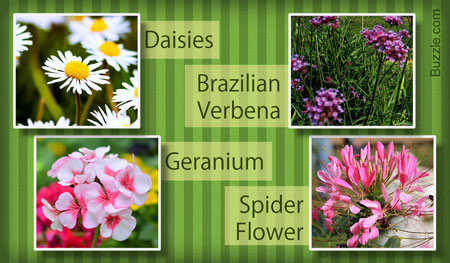 Annuals complete their life cycle in one season, i.e., they grow, flower, bear seeds, and die in the same season. They are most preferred for planting in bedding schemes, rather than growing at the borders. You can create a different flower bed in each season by planting annuals. Another advantage of selecting annual flowers is that they are available in a wide range of colors.Some of the best choices are geraniums, spider flowers, Brazilian verbena, and daisies. You can design a color scheme by planting different annual flowers in the same bed. While doing so, make sure that the plants in one flower bed bloom at the same time. Annual flowers also serve as great space fillers before the perennials start blooming.Biennial and Perennial Plants
Annuals complete their life cycle in one season, i.e., they grow, flower, bear seeds, and die in the same season. They are most preferred for planting in bedding schemes, rather than growing at the borders. You can create a different flower bed in each season by planting annuals. Another advantage of selecting annual flowers is that they are available in a wide range of colors.Some of the best choices are geraniums, spider flowers, Brazilian verbena, and daisies. You can design a color scheme by planting different annual flowers in the same bed. While doing so, make sure that the plants in one flower bed bloom at the same time. Annual flowers also serve as great space fillers before the perennials start blooming.Biennial and Perennial Plants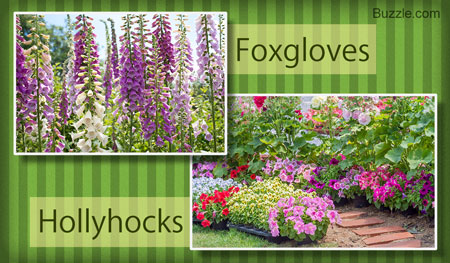 Biennials develop their leaves in the first season and bloom in the next season. Then they shed their seeds and die. They are best planted at the borders and the hedges along with perennials. The most preferred biennials for flower gardens are foxgloves and hollyhocks. Perennial flowers are long-living plants, which bloom for a short duration (about 3-4 weeks) in each season. You can select perennials that flower at different times, so as to make the flower garden look lively. This way, there will be blooms in the garden throughout the year, irrespective of the season.
Biennials develop their leaves in the first season and bloom in the next season. Then they shed their seeds and die. They are best planted at the borders and the hedges along with perennials. The most preferred biennials for flower gardens are foxgloves and hollyhocks. Perennial flowers are long-living plants, which bloom for a short duration (about 3-4 weeks) in each season. You can select perennials that flower at different times, so as to make the flower garden look lively. This way, there will be blooms in the garden throughout the year, irrespective of the season.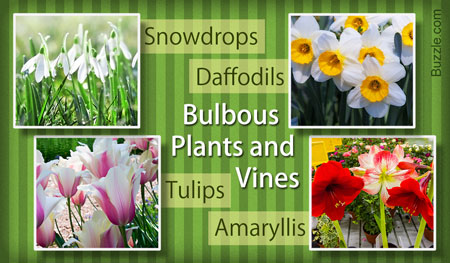 Other flowering plants include bulbs and climbing vines. Bulbs are very easy to grow and maintain in the garden. They flower in one season, remain dormant for a while, and again flower in the next season. Some of the stunning bulbous plants are tulips, daffodils, amaryllis, and snowdrops. If there are trellises, you can give a different look to your garden by growing climbing vines. Flowering vines like morning glory and hyacinth bean can be planted based on the color scheme of the surrounding area.Garden with a Lawn
Other flowering plants include bulbs and climbing vines. Bulbs are very easy to grow and maintain in the garden. They flower in one season, remain dormant for a while, and again flower in the next season. Some of the stunning bulbous plants are tulips, daffodils, amaryllis, and snowdrops. If there are trellises, you can give a different look to your garden by growing climbing vines. Flowering vines like morning glory and hyacinth bean can be planted based on the color scheme of the surrounding area.Garden with a Lawn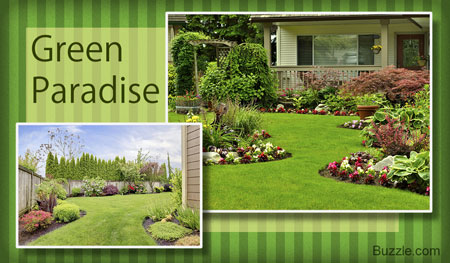 This idea is for a large sized garden, where you have sufficient room to incorporate a green patch. For lawns, ornamental grasses are maintained for enjoying greenery in all seasons. Once planted, they continue to grow for many years, provided that proper care tips are adopted. In short, a lawn requires less maintenance than a flower bed. For people who have limited time for garden care, a lawn garden adorned with ground cover and flower beds is a perfect option. You can also include evergreen shrubs on the lawn boundary.
This idea is for a large sized garden, where you have sufficient room to incorporate a green patch. For lawns, ornamental grasses are maintained for enjoying greenery in all seasons. Once planted, they continue to grow for many years, provided that proper care tips are adopted. In short, a lawn requires less maintenance than a flower bed. For people who have limited time for garden care, a lawn garden adorned with ground cover and flower beds is a perfect option. You can also include evergreen shrubs on the lawn boundary.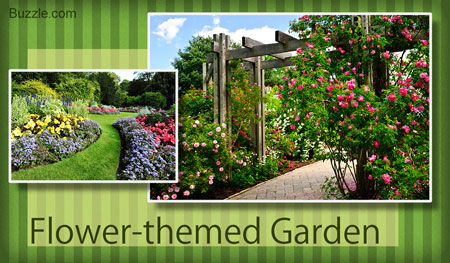 You may consider using containers and/or raised beds in the center of the lawn or in the borders. Fill the empty space with potted plants and your garden will definitely look complete. If interested, try experimenting theme-based flower garden design ideas. You can focus on a particular theme, like a butterfly garden, rose garden, summer garden, and proceed accordingly.
You may consider using containers and/or raised beds in the center of the lawn or in the borders. Fill the empty space with potted plants and your garden will definitely look complete. If interested, try experimenting theme-based flower garden design ideas. You can focus on a particular theme, like a butterfly garden, rose garden, summer garden, and proceed accordingly.
Copyright © www.100flowers.win Botanic Garden All Rights Reserved